Introduction
In the rapidly evolving landscape of technology, organizations are increasingly recognizing the imperative of adopting DevOps practices to enhance operational efficiency and drive innovation. A DevOps Readiness Assessment emerges as a critical tool in this transformative journey, providing a structured framework to evaluate an organization’s preparedness for such an integration. By systematically analyzing cultural alignment, technical capabilities, and existing processes, these assessments not only identify potential gaps but also highlight strengths that can be leveraged for success.
As businesses gear up for 2024, the projected surge in DevOps readiness assessments signals a growing acknowledgment of their strategic importance. This article delves into the multifaceted nature of DevOps Readiness Assessments, exploring their significance, the steps involved in conducting them, and the essential components that contribute to a successful evaluation, ultimately guiding organizations toward a more cohesive and effective DevOps implementation.
Defining DevOps Readiness Assessment: An Overview
A devops readiness assessment serves as a strategic framework to evaluate a company's preparedness for adopting development and operations practices. This systematic evaluation encompasses key dimensions such as cultural alignment, technical capabilities, and current processes. By recognizing both gaps and strengths, entities can develop focused strategies that enhance their implementation of development and operations.
The significance of this devops readiness assessment is underscored by the expectation that a considerable number of entities will perform readiness evaluations in 2024, indicating an increasing acknowledgment of its worth. As Dhruv Joshi aptly states,
Comprehensive testing is crucial for ensuring the harmony of your software.
This comprehensive perspective not only clarifies a company's current position concerning development operations methodologies but also acts as a guiding compass for the transformation journey.
Moreover, with Kubernetes being adopted by over 50% of Fortune 100 companies, and the continuous integration tools market valued at $1.4 billion and expected to grow to $3.72 billion by 2029, the emphasis on performing a devops readiness assessment becomes even more vital for entities seeking to thrive in a cloud-native landscape. Additionally, effective development and operations practices can lead to significant financial benefits, as evidenced by Drift's annual savings of $2.4 million on AWS costs.
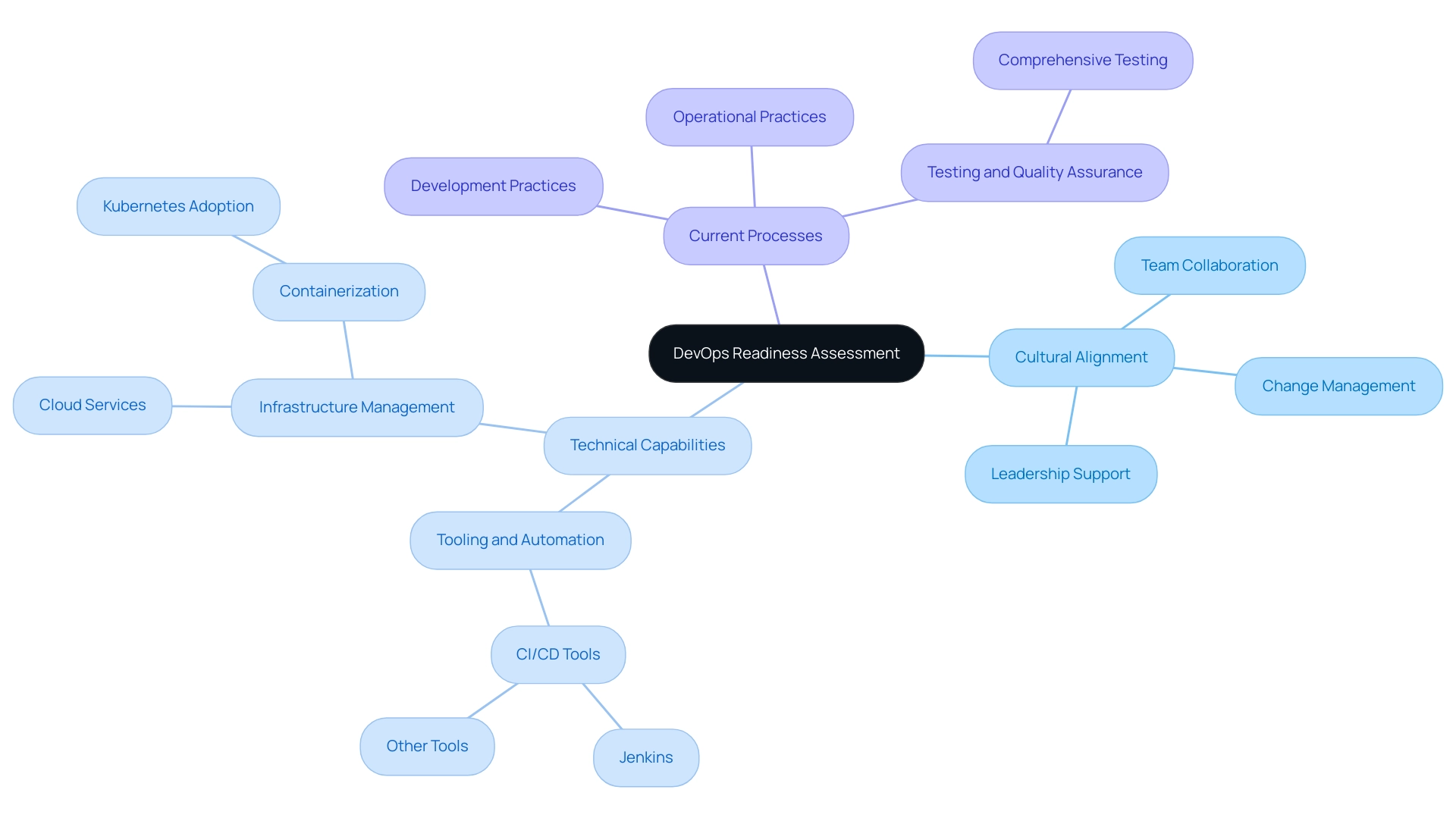
The Importance of DevOps Readiness Assessments for Organizations
Conducting a DevOps readiness assessment is pivotal for organizations seeking to bolster their operational efficiency and effectiveness. These evaluations are instrumental in pinpointing areas for improvement while aligning teams around shared objectives. As emphasized by recent findings, 85% of IT leaders assert that collaborative practices are vital for successful digital transformation, underlining the importance of readiness in this context.
Furthermore, a notable 72% of respondents reported that they are unifying security and observability, which emphasizes the crucial role of readiness assessments in enhancing software security. By assessing current capabilities and recognizing limitations, organizations can effectively reduce risks associated with the adoption of development and operations practices, facilitating a smoother transition process and leading to the faster delivery of high-quality software. For instance, the case study titled 'Collaboration in DevOps' illustrates how DevOps improves collaboration between development and operations, enabling faster delivery of high-quality releases through streamlined workflows.
Furthermore, the incorporation of containers and Kubernetes, which are commonly utilized for their automation and scalability, underscores the importance of DevOps readiness assessment in today's tech landscape. Moreover, conducting a DevOps readiness assessment fosters a culture of ongoing enhancement, preparing entities for enduring success in the face of rising competition. Success narratives are plentiful, with many entities reporting substantial operational efficiency improvements through focused evaluations, showcasing their present advantages and strategic significance in today's technological environment.
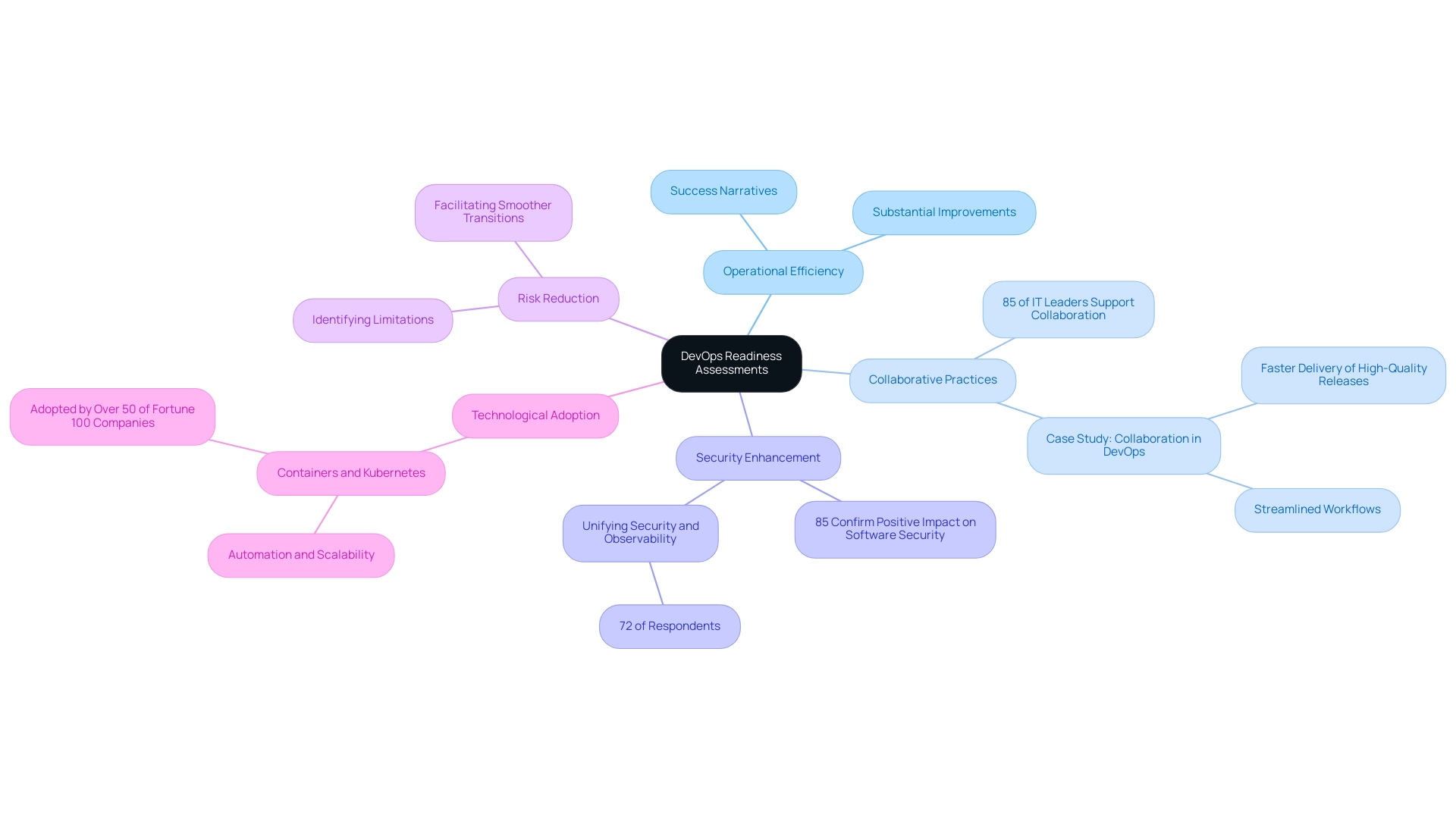
Steps to Conducting a DevOps Readiness Assessment
To effectively conduct a DevOps Readiness Assessment, organizations should implement a structured approach encompassing the following essential steps:
- Define Objectives: Establish clear goals for the assessment to align expectations and objectives among all stakeholders involved.
- Gather Data: Systematically collect pertinent information regarding existing operations, tools, and team dynamics. This can be achieved through a combination of surveys, interviews, and thorough documentation reviews, ensuring a comprehensive understanding of the current environment. As mentioned by Splunk, 'Build a strong data foundation with Splunk,' emphasizing the significance of data collection and analysis in this endeavor.
- Evaluate Current State: Analyze the gathered data with a focus on assessing the organization's readiness across cultural, technical, and process dimensions. This evaluation serves as the foundation for identifying strengths and weaknesses within the current framework.
- Identify Gaps: Highlight specific areas where the current practices do not meet established best practices for development and operations. This identification is crucial for targeting improvements that will enhance overall performance and alignment with industry standards.
- Develop Action Plan: Formulate a detailed roadmap outlining the necessary steps to bridge identified gaps and enhance preparedness for adopting development and operations practices. This plan should include timelines, resource allocations, and key milestones to guide implementation.
- Engage Stakeholders: Actively involve all relevant parties to ensure buy-in and support throughout the transformation process. Engaging stakeholders fosters collaboration and commitment, which are vital for successful implementation.
- Monitor Progress: Establish metrics to continuously track improvements and assess the effectiveness of the action plan. Employing DORA metrics provides a framework for measuring software development and delivery performance, allowing entities to showcase the value of their development initiatives to stakeholders. Additionally, entities should be aware of the mean time to restore service benchmarks:
- Elite (less than one hour)
- High (less than one day)
- Medium (between one day and one week)
- Low (more than six months) as these indicators can inform performance expectations.
By following this systematic method, entities can enhance their DevOps readiness assessment, ultimately resulting in better operational efficiency and service recovery durations. Moreover, tools such as Atlassian’s Open Development Operations can offer practical assistance throughout the evaluation process, emphasizing the significance of a robust data foundation in today’s rapidly changing technological environment.
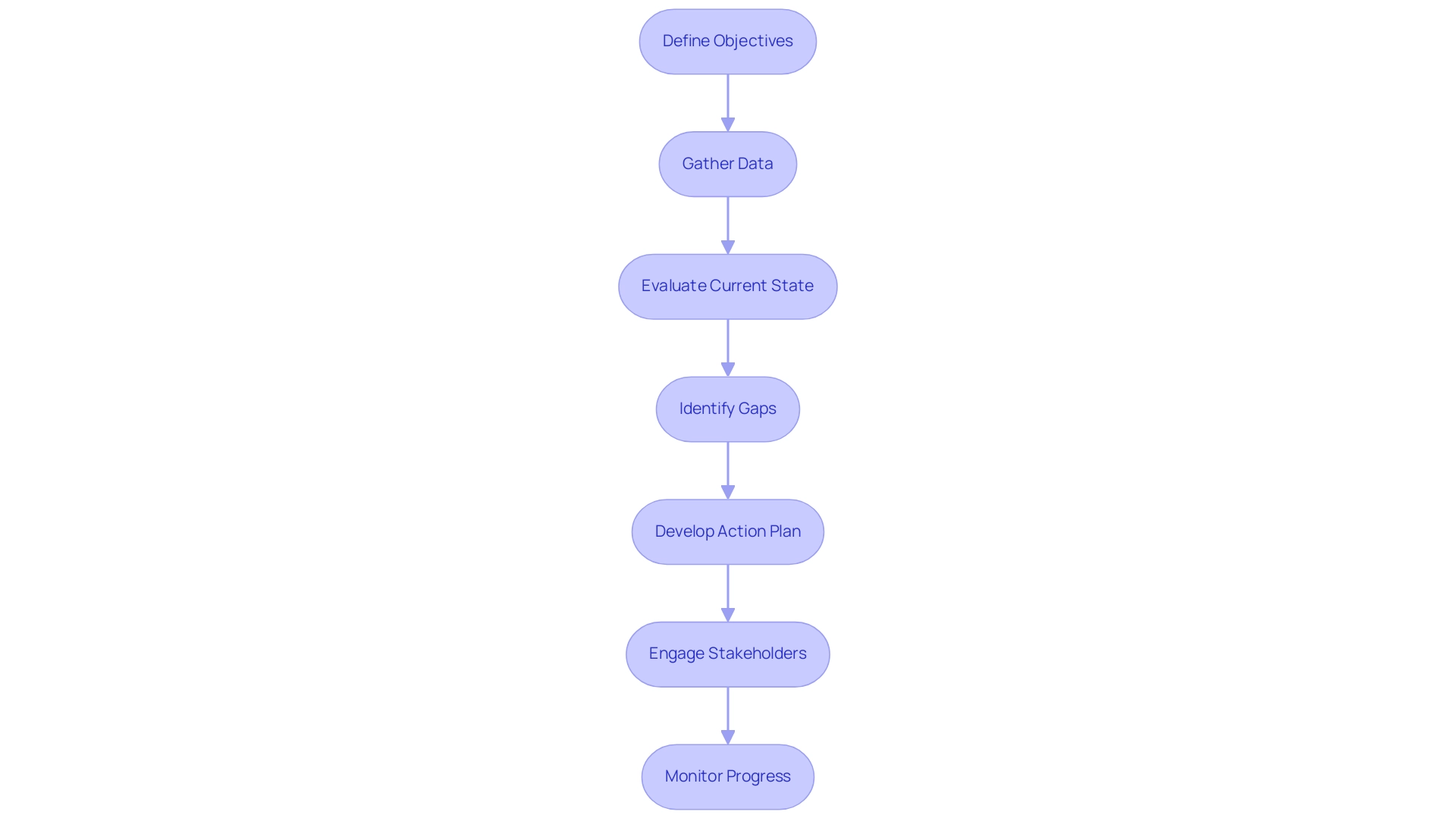
Key Components of a Successful DevOps Readiness Assessment
A successful devops readiness assessment for development and operations is essential for entities aiming to enhance collaboration, accelerate delivery, and improve product quality. This assessment should encompass several key components:
- Cultural Assessment: Evaluating the organization's culture is crucial to determine its alignment with development and operations principles, including collaboration, transparency, and continuous improvement.
According to industry insights, the devops readiness assessment indicates that cultural readiness significantly impacts the effectiveness of development and operations practices.
- Technical Capabilities: An evaluation of the current technology stack, tools, and infrastructure will assist in identifying gaps in automation, integration, and deployment. With over half of the surveyed teams utilizing containers through development and operations practices, ensuring the right technical capabilities is crucial for success.
This statistic underscores the necessity of aligning technical resources with modern deployment strategies.
- Process Evaluation: Reviewing current workflows and processes is necessary to gauge their efficiency and adaptability to development operations methodologies. This evaluation sets the stage for a devops readiness assessment aimed at optimizing practices that enhance delivery speed and product reliability.
Establishing clear metrics is vital for measuring success and progress in the devops readiness assessment and adopting development and operations practices. Key performance indicators such as deployment frequency, lead time for changes, and mean time to recover from failures provide invaluable insights into the organization's development and operations journey. Notably, high-performing teams in development and operations integrate automated testing into their workflows 70% of the time, a crucial metric that enhances efficiency and reduces errors, making it a cornerstone of successful implementations.
- Stakeholder Engagement: Involving key stakeholders from various departments ensures diverse perspectives are taken into account, fostering a collaborative environment for the evaluation. Involving stakeholders also assists in aligning the organization’s broader strategic objectives with the development and operations initiatives.
Ben Lloyd Pearson aptly summarizes the value of this comprehensive approach:
Learn how the Quality Maturity Model integrates 14 dimensions of software quality with developer productivity metrics for better efficiency and strategic alignment.
This integration of cultural, technical, and process assessments not only paves the way for successful implementation but also aligns with the growing trend in cloud services, projected to increase substantially from 2022 to 2024.
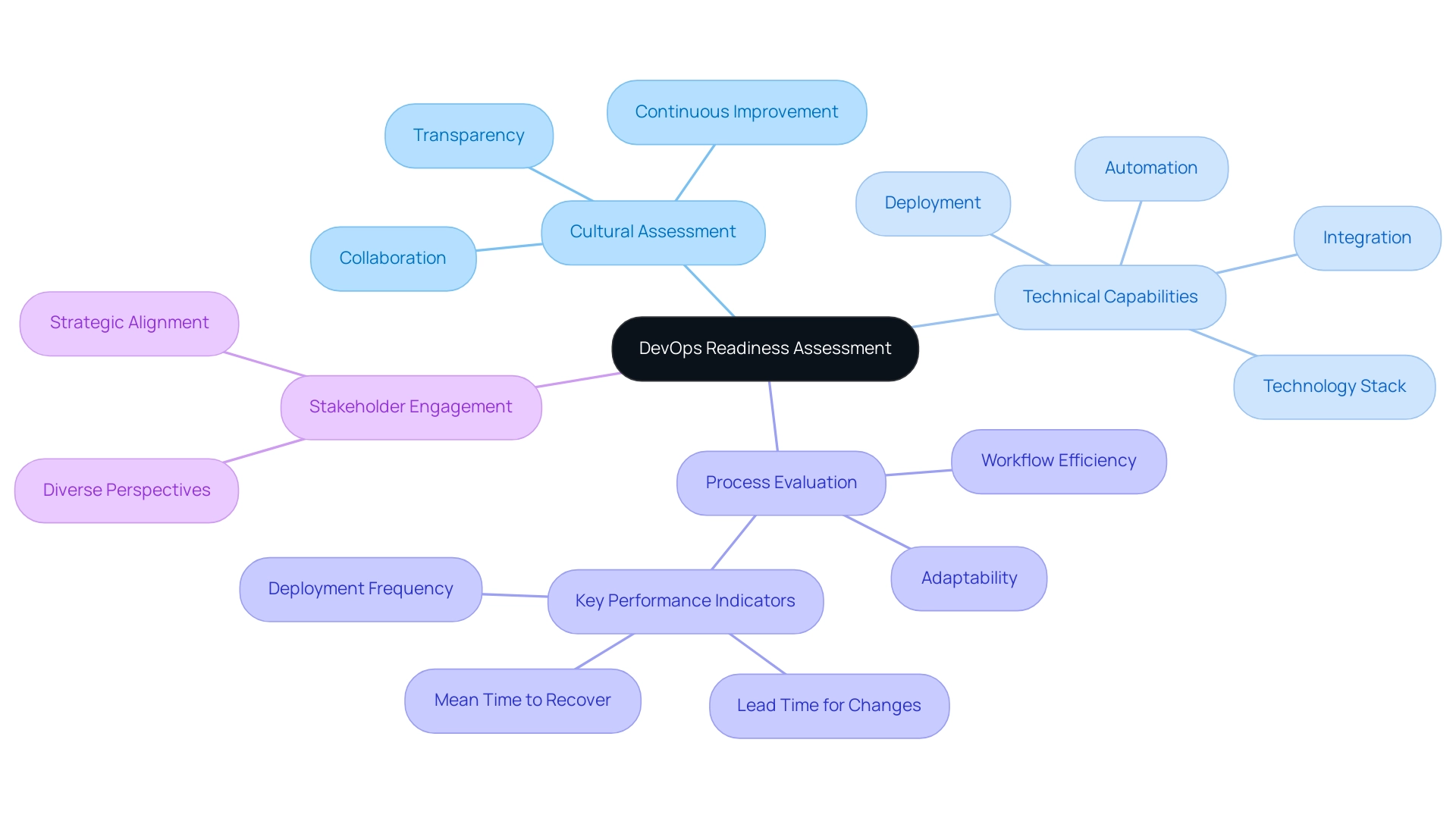
Overcoming Challenges in DevOps Transformation Through Readiness Assessments
Organizations shifting to a collaborative development and operations model frequently encounter significant challenges that can hinder their progress, including:
- Resistance to change
- Skill gaps
- Misalignment between teams
Recent insights reveal that over 72% of respondents are actively working to unify security with observability and monitoring, underscoring the critical need for a cohesive approach in software development transformation. It's noteworthy that more than half of teams surveyed utilize modern practices to deploy containers, highlighting the rising adoption of Kubernetes and container technologies as organizations pursue cloud-native solutions.
A comprehensive devops readiness assessment serves as a vital instrument in addressing these challenges. The evaluation, known as a devops readiness assessment, provides a clear understanding of the current state and identifies specific areas for enhancement, such as cultural resistance that may hinder collaboration across teams. With this knowledge, entities can implement targeted change management strategies that foster a more inclusive and cooperative environment.
Furthermore, the devops readiness assessment highlights skill gaps, which enables companies to invest in tailored training and development initiatives to equip their teams with the necessary capabilities. This proactive method not only facilitates the transformation process but also enables entities to fully reap the advantages of adopting practices related to development and operations. For instance, CloudZero provides a comprehensive platform for managing cloud costs, offering insights into cost per customer, team, and deployment.
Companies like Drift have saved $2.4 million yearly on AWS expenses by utilizing CloudZero's services, demonstrating how effective management can overcome challenges in technology transformation. Additionally, it's important to note that 6.8% of companies using DevOps are from India, providing a broader context of the global landscape of DevOps adoption and the challenges faced by organizations in different regions.
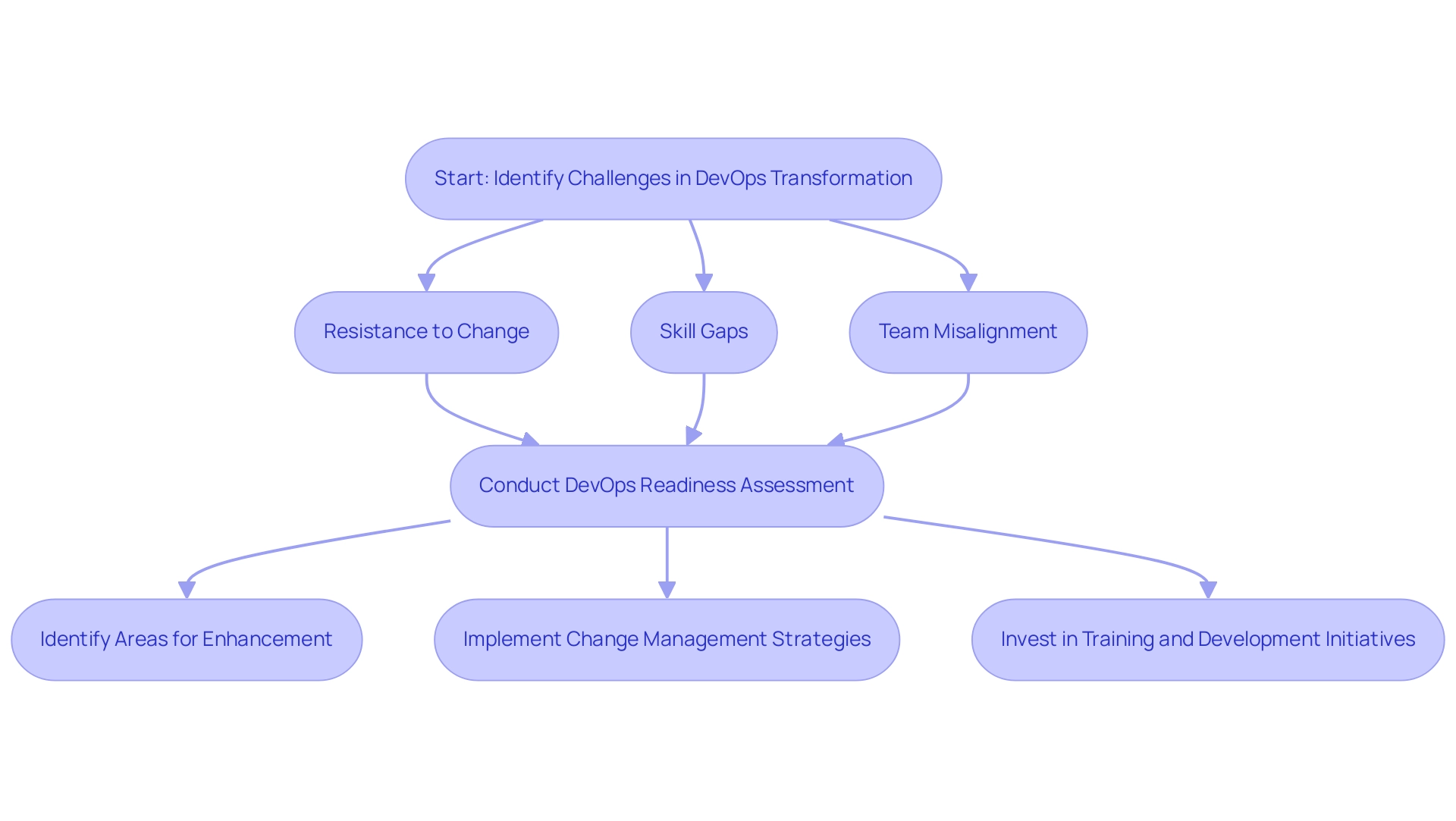
Conclusion
The significance of DevOps Readiness Assessments cannot be overstated in today’s technological landscape. These assessments serve as a foundational framework for organizations aiming to adopt DevOps practices effectively. By evaluating cultural alignment, technical capabilities, and existing processes, organizations can pinpoint both strengths to leverage and gaps to address, ultimately facilitating a smoother transition to a more collaborative and efficient operational model.
As organizations prepare for the anticipated surge in DevOps readiness assessments in 2024, it becomes clear that these evaluations are not merely optional, but essential for achieving operational excellence and fostering innovation. The structured approach to conducting these assessments—ranging from defining objectives to engaging stakeholders—ensures comprehensive insights into the current state of readiness, paving the way for strategic improvements.
Moreover, the challenges encountered during DevOps transformation, such as resistance to change and skill gaps, can be effectively mitigated through targeted readiness assessments. By identifying specific areas for improvement and aligning teams around shared goals, organizations can cultivate a culture of continuous improvement. This proactive strategy not only enhances collaboration but also empowers teams to fully capitalize on the benefits of DevOps practices.
In summary, embracing DevOps Readiness Assessments is a strategic imperative for organizations aspiring to thrive in a competitive environment. By systematically addressing the nuances of readiness, organizations position themselves to achieve significant operational efficiencies and innovation, ultimately driving success in the ever-evolving digital landscape.




